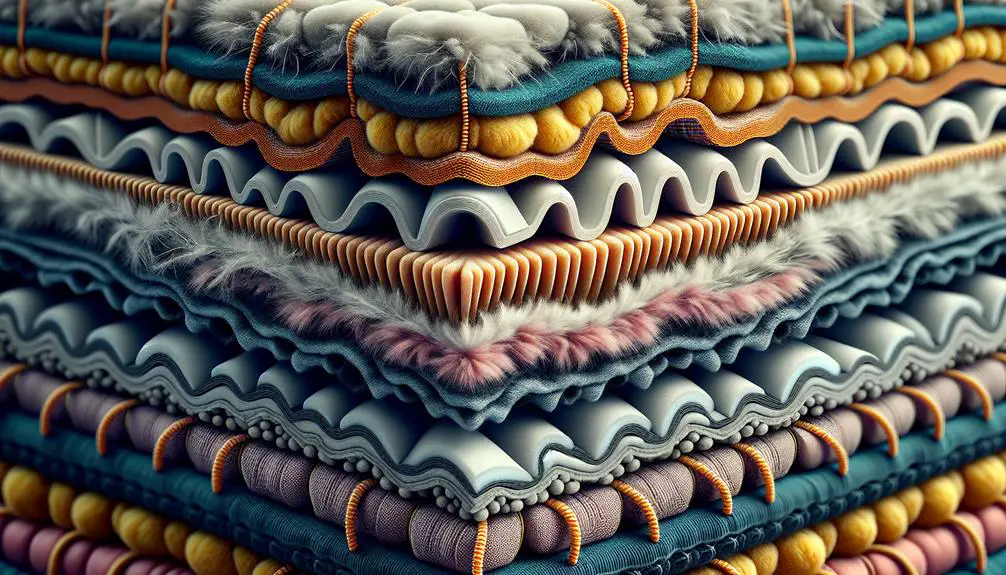Ever wondered what thermal clothes are made of? The answer might surprise you. From cozy natural fibers to high-tech synthetic materials, thermal wear comes in a variety of compositions.
Whether it's the warmth of wool, the versatility of polyester, the breathability of cotton, the stretch of spandex, or the best of all worlds in blends, the materials used in thermal clothing play an important role in keeping us comfortable in chilly weather.
But what really sets these fabrics apart? Let's uncover the secrets behind the layers that keep us warm and snug.
Table of Contents
Key Takeaways
- Thermal clothes are made of natural fibers like wool and cotton, as well as synthetic materials such as polyester and nylon.
- Synthetic fibers like polyester and nylon offer durability, moisture-wicking capabilities, and lightweight insulation for thermal clothing.
- Blends of materials like spandex, wool, fleece, nylon, and polyester enhance comfort, performance, and longevity in thermal clothes.
- Breathable and moisture-wicking properties in thermal clothes are crucial for regulating body temperature and ensuring comfort during various activities.
Natural Fibers
When it comes to thermal clothes, natural fibers provide excellent insulation and comfort for outdoor activities. These fibers, sourced from renewable materials, offer sustainability, making them an environmentally friendly choice. Not only are natural fibers kind to the planet, but they also offer exceptional comfort and softness against the skin.
Cotton is a popular natural fiber used in thermal clothing. It's breathable, lightweight, and soft, making it perfect for a wide range of outdoor pursuits. Additionally, wool is another fantastic natural fiber known for its excellent insulation properties. Wool can retain warmth even when wet, making it ideal for cold and damp conditions. Moreover, bamboo fibers, derived from bamboo grass, are gaining popularity in thermal wear due to their sustainability and luxurious feel against the skin.
Synthetic Materials
I'm excited to talk about synthetic materials in thermal clothing.
Synthetic fibers bring a host of benefits, such as being lightweight, moisture-wicking, and quick-drying.
The durability of synthetics makes them great for outdoor activities, while their breathability guarantees comfort during various physical pursuits.
Synthetic Fiber Properties
Exploring the domain of synthetic fiber properties reveals a world of versatility and innovation in the domain of thermal clothing materials. Synthetic fibers like polyester and nylon excel in moisture-wicking, drawing sweat away from the skin to keep you dry and comfortable.
These fibers are also known for their lightweight insulation properties, providing warmth without adding bulk. By weaving these synthetic fibers into thermal clothing, manufacturers create garments that regulate body temperature, making them ideal for various outdoor activities or cold-weather conditions.
The combination of moisture-wicking and lightweight insulation in synthetic fibers allows for efficient moisture management and heat retention, ensuring that wearers stay warm and dry in challenging environments.
Durability of Synthetics
Synthetic fibers like polyester and nylon not only excel in moisture-wicking and lightweight insulation properties but also boast impressive durability, making them reliable choices for long-lasting thermal clothing. Their synthetic durability guarantees longevity, providing thermal efficiency wear after wear. These materials are engineered to withstand the demands of various activities while retaining their shape and performance. Here is a comparison table showcasing the durability of polyester and nylon:
| Property | Polyester | Nylon |
|---|---|---|
| Strength | High | Very High |
| Abrasion Resistance | Excellent | Exceptional |
| Stretch | Limited stretch | Moderate stretch |
When it comes to thermal wear, the durability of synthetics like polyester and nylon guarantees that your clothing remains robust and functional through countless adventures.
Breathability in Synthetics
Breathable synthetic materials enhance comfort by allowing air circulation, optimizing the wearing experience during various activities. Moisture-wicking fabrics pull sweat away from the body, keeping you dry and preventing chafing. This feature is especially beneficial during intense workouts or in hot climates.
Additionally, synthetic materials excel in temperature regulation by helping to keep you cool in warm weather and warm in cold conditions. The fibers' ability to transport moisture away from the skin aids in maintaining a consistent body temperature, reducing the risk of overheating or feeling too cold.
When engaging in physical activities, the breathability of synthetic materials plays a key role in enhancing overall performance and ensuring a pleasant wearing experience.
Wool
I love wearing wool because of its fantastic insulating properties that keep me warm in chilly weather.
Not only does wool keep me cozy, but its breathability also helps regulate my body temperature, making it a versatile choice for various climates.
Whether I'm hiking in the mountains or enjoying a leisurely stroll in the park, wool is my go-to for comfort and performance.
Insulating Properties of Wool
Wool's insulating properties make it a popular choice for cold weather clothing due to its ability to trap heat close to the body. This natural fiber creates tiny air pockets that retain warmth, keeping you cozy in chilly conditions.
Wool insulation works by absorbing moisture vapor from the body, which then evaporates into the air, helping regulate temperature and prevent overheating. Additionally, wool is excellent at wicking away sweat, drawing moisture away from the skin to keep you dry and comfortable.
Its insulating capabilities even work when wet, unlike many synthetic materials. This unique combination of wool insulation and moisture-wicking properties makes it an ideal option for staying warm and dry in various outdoor activities during the winter months.
Breathability of Wool
Often overlooked, the breathability of wool plays an essential role in its effectiveness as a thermal clothing material. Wool's natural breathability allows it to regulate body temperature by wicking away moisture from the skin. This process helps to keep you dry and comfortable in various weather conditions.
Unlike synthetic fabrics, wool can absorb large amounts of moisture without feeling damp, making it an excellent choice for thermal wear. Additionally, advancements in moisture-wicking technologies have further enhanced wool's breathability, ensuring that sweat is efficiently pulled away from the body.
Polyester
Polyester blends innovation with functionality, making it a versatile material for thermal clothes. As someone who appreciates both performance and comfort in my garments, polyester's benefits shine through. While it may not have the natural feel of wool, polyester excels in moisture-wicking, quick drying, and durability. These qualities are important for staying warm and dry in various activities, from hiking to skiing.
To better understand the role of polyester in thermal clothing, let's explore its key attributes:
| Polyester Attributes | Description | Benefits |
|---|---|---|
| Moisture-Wicking | Draws sweat away from the skin | Keeps you dry and comfortable |
| Quick Drying | Dries rapidly after getting wet | Reduces discomfort and chafing |
| Durability | Resistant to wear and tear | Ensures long-lasting performance |
While polyester offers impressive benefits, sustainability concerns, such as microplastic pollution, are important to take into account. Despite this, when looking for efficient and reliable thermal wear, polyester remains a top contender in my wardrobe.
Cotton
Cotton, a natural and breathable fabric, offers a cozy and comfortable alternative for thermal clothing. When it comes to thermal clothes, cotton provides numerous benefits beyond just warmth. Here are some key points to take into account:
- Moisture Wicking: Cotton has excellent moisture-wicking properties, making it ideal for thermal wear. It absorbs sweat from the body, keeping you dry and comfortable during various activities.
- Layering Techniques: Cotton thermal clothes are versatile for layering. They can be easily combined with other garments to create customized levels of warmth, making them perfect for adjusting to changing temperatures.
- Sustainable Options: Cotton is a sustainable choice for thermal clothes. It's biodegradable and renewable, offering eco-friendly benefits that align with environmentally conscious practices.
- Eco-Friendly Benefits: Choosing cotton thermal clothes supports sustainable farming practices and reduces the environmental impact of clothing production. It's a natural option that promotes a healthier planet while keeping you snug and stylish.
Spandex
Crafting thermal clothes with Spandex infuses flexibility and stretch into the fabric, guaranteeing a snug fit that moves with your body. Spandex, recognized for its elasticity and comfort, is a crucial component in enhancing the performance of thermal wear. Its capacity to stretch up to five times its original length provides a form-fitting design without restricting movement. Additionally, Spandex is excellent for moisture-wicking, keeping you dry and comfortable during physical activities or in cold weather.
| Benefits of Spandex in Thermal Clothes |
|---|
| 1. Elasticity: Allows for a snug and flexible fit. |
| 2. Comfort: Ensures comfort during movement. |
| 3. Moisture Wicking: Keeps you dry by drawing sweat away. |
Incorporating Spandex into thermal wear not only enhances the overall comfort and fit but also boosts the garment's performance, making it an ideal choice for those seeking both functionality and style.
Blends
When it comes to thermal clothes, exploring blends of various materials opens up a world of possibilities for enhancing performance and comfort. Blending different fabrics can create a garment that not only keeps you warm but also guarantees a comfortable fit and effective moisture-wicking properties.
Here are some key aspects to take into account when looking at blends for thermal clothing:
- Comfortable Fit: Blending materials like spandex or elastane with natural fibers such as cotton or wool can provide a stretchy and snug fit that moves with your body, offering maximum comfort during activities.
- Moisture Wicking: Combining moisture-wicking synthetic fibers like polyester with breathable fabrics helps in pulling sweat away from the skin, keeping you dry and comfortable even during intense workouts.
- Insulation: Blends of insulating materials like wool or fleece with lightweight synthetic fibers trap heat effectively, providing warmth without adding bulk.
- Durability: Mixing durable fibers like nylon or polyester with natural fibers enhances the garment's longevity, ensuring that your thermal clothes last through many wears and washes.
Frequently Asked Questions
Are Thermal Clothes Only Suitable for Winter Weather, or Can They Be Worn in Other Seasons as Well?
Thermal clothes offer more than just winter warmth. Their layering options provide versatility for various seasons. With their breathable materials, they guarantee comfort year-round. From chilly spring mornings to cool fall evenings, thermal wear has you covered.
How Do I Properly Care for and Maintain Thermal Clothes to Ensure They Last a Long Time?
To properly care for thermal clothes and guarantee longevity, I recommend proper storage in a cool, dry place. When washing, opt for gentle cycles with mild detergent to maintain fabric integrity. These steps will help them last.
Can Thermal Clothes Be Worn as Standalone Pieces, or Are They Primarily Meant to Be Worn as an Extra Layer Under Regular Clothing?
I find thermal clothes versatile. They can be styled as standalone pieces or worn as extra layers for added warmth. Their comfort is unmatched, and they offer great durability and breathability, making them perfect for various activities.
Are Thermal Clothes Only Available in Basic Colors, or Are There More Fashionable Options to Choose From?
Fashionable designs and trendy options make thermal clothes more versatile. They come in various stylish choices beyond basic colors. Performance materials not only keep you warm but also offer a chic wardrobe addition for any occasion.
Are There Any Potential Allergens in Thermal Clothes That Could Cause Skin Irritation or Other Reactions?
When considering fabric composition in thermal clothes, it's important to look for allergen-free options to avoid potential reactions like skin irritation. Some materials might trigger sensitivity, so being aware can help in finding comfortable alternatives.
- Tetron Fabric for Marine Applications: Durability and Use Cases - June 18, 2025
- Tetron Fabric for Outdoor Furniture: Weather Resistance and Care - June 18, 2025
- Tetron Fabric for Wall Coverings: Style and Application Tips - June 18, 2025







